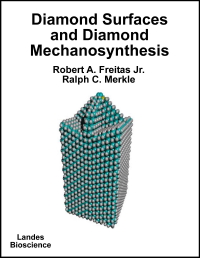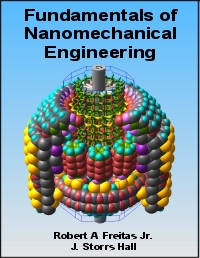Welcome to the
Molecular
Assembler
website
©
2003-2024 Robert A.
Freitas Jr. All Rights Reserved.
Molecular nanotechnology involves the ability to build structures
that are permitted by physical laws, to molecular precision. I am primarily
interested in positional assembly, which is a deterministic process in which
the components used in a construction are held in known positions and are constrained
to follow desired intermediate physical pathways during the entire construction
sequence. Programmable positional assembly at the molecular scale is the central
mechanism for achieving both great flexibility and the ultimate in precision
and quality in manufacturing. An early proposal for the next logical R&D
step is here,
a technical
bibliography for research on positional
diamondoid mechanosynthesis is available here,
and the first patent ever filed on positional diamond mechanosynthesis is available
here.
The other key to practical molecular manufacturing is the ability to fabricate
massive quantities of molecularly precise structures, or to assemble larger
objects from vast numbers of molecularly precise smaller objects – that
is, massively parallel assembly. The end result of this development process
will be a basic molecular assembler that employs machine-phase nanotechnology
(e.g., nanoscale gears, struts, springs, motors, casings) to fabricate molecularly
precise diamondoid structures, following a set of instructions to build a desired
specific design.
With Ralph Merkle, I’ve undertaken theoretical analyses
of possible molecular assembler systems. I’m co-authoring at least two
technical books describing the
results of this research. The first book, Kinematic
Self-Replicating Machines, was published in October 2004 and was available
at a substantial prepublication discount directly from Landes Bioscience.
The second volume, Diamond
Surfaces and Diamond Mechanosynthesis, is in progress and should be published
in 2007-2008. The third volume, Fundamentals of Nanomechanical Engineering originally
to be co-authored with J. Storrs Hall, is still in progress and might be published
in 2009-2010.
Our international research collaborations, ultimately leading
toward the development of a working nanofactory, are described at the Nanofactory
Collaboration website.
 |
|
Kinematic
Self-Replicating Machines (Landes
Bioscience, 2004). This book
offers a general review of the voluminous theoretical and experimental
literature pertaining to physical self-replicating systems and self-replication.
The principal focus here is on self-replicating machine systems. Most
importantly, we are concerned with kinematic self-replicating machines:
systems in which actual physical objects, not mere patterns of information,
undertake their own replication. Following a brief burst of activity
in the 1950s and 1980s, the field of kinematic replicating systems design
received new interest in the 1990s with the emerging recognition of
the feasibility of molecular nanotechnology. The field has experienced
a renaissance of research activity since 1999 as researchers have come
to recognize that replicating systems are simple enough to permit experimental
laboratory demonstrations of working devices.
Read
Text free online ..... Purchase
Hardcover online ..... Purchase
Hardcover online ..... Advance Discount Purchase directly from Landes
Bioscience ..... German
Translation of Chapter 1 (HTML)
|
 |
|
Diamond
Surfaces and Diamond Mechanosynthesis (2008-09, in preparation).
A full analysis of how to use programmable positional assembly to synthesize
most arrangements of atoms permitted by physical law would be, at present,
prohibitively complex. A more manageable project is to analyze a significant
class of stiff hydrocarbons – in particular, diamond – that
could potentially be synthesized by the use of a small set of positionally
controlled mechanosynthetic tool tips. There is already widespread interest
in the exceptional properties of diamond such as extreme hardness, high
strength and stiffness, high thermal conductivity, low frictional coefficient,
chemical inertness, and a wide bandgap. The molecular surface characteristics
of diamond were extensively investigated both theoretically and experimentally
in the 1990s, and many practical questions about the molecular structure
of diamond surfaces have now been resolved. The fields of diamond CVD
and adamantane chemistry provide additional understanding, both experimental
and theoretical, of the myriad reaction mechanisms which can contribute
to the growth of diamond.
A technical bibliography for research on positional
mechanosynthesis is available here.
The first patent ever filed on positional diamond mechanosynthesis is
available here.
See also the Nanofactory
Collaboration website for the larger context of this research.
|
 |
|
Fundamentals of Nanomechanical Engineering (2009-10,
in preparation). This course textbook, intended for use by
2nd or 3rd year college students in advanced engineering programs, will
provide a solid grounding in the practical design of molecular scale
machines composed of rigid covalent solids, with a strong emphasis on
diamond and diamondoid materials. After an introduction to the unique
aspects of nanoscale machinery and a review of the computational tools
currently available to assist such designs, the mechanical characteristics
of key materials and the fundamentals of load, stress, stiffness, and
mechanical failure in nanoscale machinery will be explored in detail.
This will be followed by discussions and examples of specific nanomechanical
components and compound machines including bearings, fasteners, gears,
linkages, drive mechanisms, motors and pumps, mechanical energy controllers,
sensors, and programmable materials.
|
Molecular Assembler website, last updated on 13 March 2024. Azerbaijanian
translation, Belarusian translation,
Croatian
translation, Georgian
translation, Kazakh
translation, Macedonian
translation, Norwegian
translation, Serbian
translation, Spanish
translation, Turkish
translation,
Urdu translation.
 since
27 June 2003
since
27 June 2003


